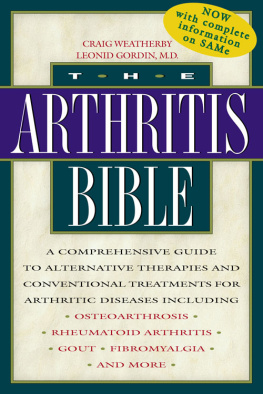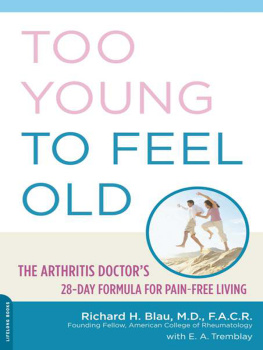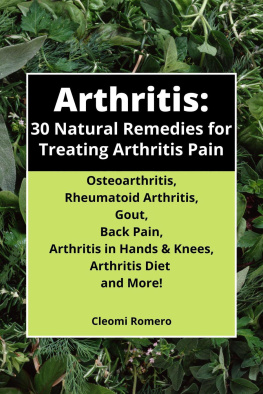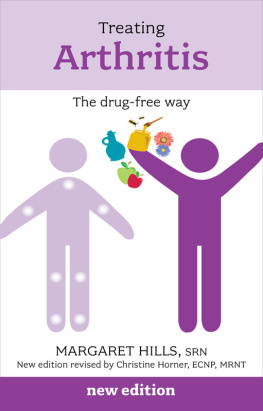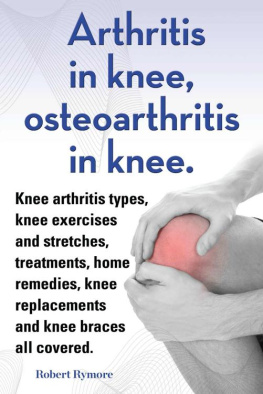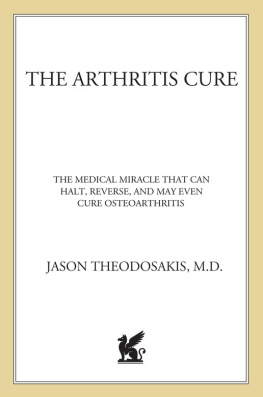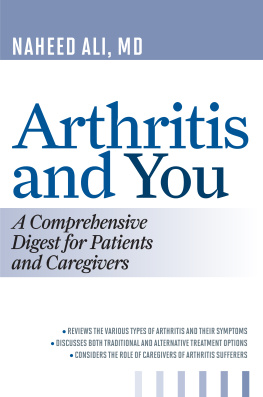
ACKNOWLEDGMENTS
I WANT FIRST AND FOREMOST TO THANK MY WIFE, Laura Inouye, for many words of encouragement and many hours of editing and extra parenting. I am also deeply indebted to old friend and medicine hunter extraordinaire Chris Kilham, whose timely invitation led me to become a health writer. Chris also suggested the books memorable moniker, and introduced me to Paul Koether, whose support made the research and writing possible (thank you, Paul). And my agent, Anne Sellaro, deserves great credit for being such a creative, energetic advocate.
Leonid Gordin, M.D., brought a trained, critical, medical eye to The Arthritis Bible, and helped me understand the pain and mysteries of arthritic diseases. His dedication, intellectual integrity, and curiosity make him an exemplary physician and most congenial coauthor. I am also grateful to Les and Lorraine Marino of the Marino Center clinic in Cambridge, Massachusetts, who facilitated our authorial collaboration.
I would like especially to acknowledge the late John F. Prudden, M.D., for his time, assistance, unpretentious attitude, and kind foreword. His pioneering cartilage therapy research deserves enduring respect and recognition. And I would be remiss not to acknowledge the brave iconoclasm of Dr. Thomas McPherson Brown. His pursuit of patient benefit in the face of institutional opposition benefited thousands and spurred vital research.
Many others provided assistance, leads, or cogent comments. I would like to acknowledge Anthony Cichoke for illuminating German research on enzyme therapy, and thank Pei Pei Wishnow, Ph.D., and Zhang Zhang Zheng, M.D., for freely sharing firsthand information on Chinese use of Lei-gong-teng and herbs in general. My thanks also go to Stephen Holt, M.D., for his candid personal views on cartilage research and his fine book, The Power of Cartilage. Natalie Koether, Esq., and Dr. Qun Yi Zheng, of Pure World Botanicals, provided timely support and assistance, for which I am grateful.
At Healing Arts Press/ITI, I would like to thank my very able and painstaking editor, Laura Schlivek, also Jon Graham and Rowan Jacobsen, and of course, Ehud Sperling, publisher extraordinaire. Thanks all for your kind efforts on behalf of The Arthritis Bible.
FOREWORD
WHEN CRAIG WEATHERBY ASKED ME TO critique his manuscript for The Arthritis Bible, I readily agreed to do so because I believe that current medical practice very much needs to raise its eyes to a much wider view of the problems with which we deal unsatisfactorily. In his encyclopedic survey of arthritis and rheumatoid afflictions, Craig Weatherby offers open-minded practitioners and patients a wealth of relevant, readable information not found in the usual consumer guides to arthritis, and he compellingly outlines the current legal and intellectual stasis that forces physicians into excessively narrow avenues of inquiry and therapy.
In my various roles as surgeon, teacher, and medical researcher, I have had considerable experience with the biases and institutional pressures that distort medical research and practice. My early explorations into the clinical effectiveness of various dosages of bovine cartilage involved highly encouraging trials in osteoarthritis, rheumatoid conditions, acceleration of wound healing, and, some years later, experimental treatment of advanced cancer. Unhappily, my efforts in these areas were greeted at worst with skeptical indifference by the members of medical academia and at best by fear of involvement based on a decidedly nonheroic apprehension about the effect on their careers if they were to actually try to confirm my results! This astonished me, since in my navet, I felt certain that the publication of results I considered epochal would provide me with an army of eager co-investigators. After all, I had shown that contrary to conventional teaching, wound healing could be consistently accelerated (previously declared a biological impossibility), rheumatoid and osteoarthritis conditions significantly improved, and advanced cancers cured with unexpected frequency by therapy with bovine cartilage. The lack of any positive reaction from colleagues and institutions whose scientific objectivity and curiosity I took for granted was originally inexplicable, but I have now concluded that the primary causes for this unexpected attitude are rooted in the nature of medical training and institutions.
Weatherby sees this clearly and ably discusses the dilemma in his preface. The basic problems are twofold: first, physicians attitudes induced by medical school and residency experiences and, second, inconsistent and illogical government regulation that strongly influences research and provider conduct. With regard to the first, the attitudes of physicians have gradually narrowed under the zealotry of regulators and the curious therapeutic rigidity of medical schools. In this way, many providers have slowly become transformed into highly skilled technicians rather than physicians. This unfortunate change occurs when a physician becomes a slavish follower of a therapeutic cookbook despite the compelling fact that his or her patient is growing worse. When the patient suggests that maybe they should try (insert anything about which the patient may have heard), the doctor often responds with Olympian anger and declares, I cant believe that you would take this unproven substance! Astonishingly, it never occurs to the physician that the therapy hitherto used on the patient has indeed been testedand proven not to work! The intellectual dilemma of such posturing never occurs to the physician-technician. It is as if the doctor has learned a catechism rather than studied medicine.
And yet, on the other side, there are the holistic and alternate armies announcing famous victories that have never taken place and spending their time hyping fantasies rather than conducting meticulous research studies that might prove their claims are glorious realities. Unhappily, therefore, we must say, A pox on both your houses. We say this since both groups are treating scientific questions in an emotional rather than an intellectual manner. And both thereby diminish their opportunity to be of service to those who have come to them in hope and trust.
The ultimate responsibility clearly rests with the leaders of academic and scientific medicine because they possess overwhelmingly more of what is needed to find the truth. But truth will never be found if they reject promising possibilities raised by lesser breeds without the law. Characteristically, all momentous new developments are initially resisted by most of those working in the affected field. Neither leading institutions nor individual investigators should ever immediately condemn ideas from left field that claim unexpected efficacy. They should bring their superior resources to the assessment of a hope that gleams from any quarter. And the law should be changed so that the Food and Drug Administration does not inexcusably slow the development of promising drugs while permitting irresponsible verbal hype for the promotion of substances labeled food supplements. The present chaotic scene is a result of this demonstrably harmful mismanagement.
I suggest that a high-level commission be constituted to recommend reasonable changes in regulations to the Congress. It should be composed of distinguished representatives of academic medicine and freestanding scientific institutions together with appropriate spokespersons for holistic and alternative medicine, nutritionists, acupuncturists, and psychologists. The greatest hope for success against disease clearly resides in those who hold leadership roles in scientific (not bureaucratic) medicine. Great care must be taken, however, to ensure that all members of the commission approach their responsibility with an intellectual openness consistent with a fair reach for promise in the observations of nonacademic medicine. They must not interpret their membership on the panel as an opportunity for self-congratulation and confirmation. On the other hand, holistic and alternative practitioners should recognize the need for rigorous scientific examination of all treatment claims. The responsibility is primarily to our patients, not to cash flow. We need to return to what was once aptly called the priesthood of medicine.
Next page
